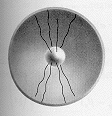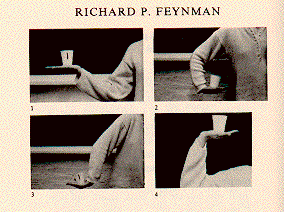
D4, D5, E6, E7 and E8 are Lie algebras, but you don't have to know what they are to get the basic ideas of the D4-D5-E6-E7-E8 VoDou Physics Model with Many-Worlds Quantum Theory. For this page, I will omit a lot of details, and I will not be at all rigorous.
It should describe the Particles that make up everything we see. The Particles are like Actors in a Play. It should describe the Spacetime in which the particles are located. The Spacetime is like the Stage of a Play. It should describe the Forces between the particles that make them move around in spacetime and interact with each other. The Forces act like the Script of a Play. Each Performance of a Play is unique, and different from every other Performance. You can say that a Play is really not just any one Performance, but the Sum Total of All Performances. Similarly, there are many different Possibilities for the Particles to be configured in Spacetime, and we can say that Many-Worlds Quantum Theory of Physics is the Sum Total of All Possibilities. Also, a Performance is influenced by interaction with its Audience, which in turn is influenced by each Performance, so that the Audience is like a mirror through which the Performance reacts with itself and with other Performances.
D4 is made up of 28 parts. Those 28 parts describe the 4 Forces of physics: 1 part of D4 carries Electromagnetism; 3 parts of D4 carry the Weak Force; 8 parts of D4 carry the Color Force; 16 parts of D4 carry Gravity and related things. With these 4 forces, we have described: Electromagnetic phenomena such as light, radio, radar, gamma rays, and magnetism, and holding atoms together by keeping electrons close to the nuclei of atoms; Weak Force phenomena such as radioactivity that makes luminous watch dials glow; Color Force phenomena such as nuclear reactions that keep the Sun burning and holding atomic nuclei together by keeping quarks close to each other inside the nuclei; Gravitational phenomena such as holding the Earth together, holding the Sun together while it burns its nuclear fuel, and holding the Solar System and the Galaxies together. Since the Forces describe how things move and interact, they are like the Script of a Play. D4 only describes the Forces. D4 does not contain either the Spacetime in which the Forces act, nor does it contain the Particles between which the Forces act. D4 is a Script without Stage or Actors.
To get the Spacetime Stage, you expand from D4 to D5. D5 contains the 28 parts of D4. but D5 has 45 parts, and the extra parts of D5 describe Spacetime as well as the Forces. Now we have a Script and Stage, but still no Actors.
To get the Actors, you expand from D5 to E6. E6 has an E6/D5xU(1) aspect that contains the 45 parts of D5 and therefore also contains, like nested Russian dolls, the 28 parts of D4, but E6 has 78 parts - one part for each Tarot card, and some of the extra parts of E6 describe the Particles upon which the Forces act within Spacetime. The Particle Actors described by E6 are called Spinors. If you want to know why they are called Spinors, click here. If you don't really care about that, just read on. Now we have Script, Stage, and Actors, so now we can perform the Play.
In addition to its E6/D5xU(1) aspect that describes the Particles, E6 has another aspect, E6/F4, that describes Possibilities:
Each performance of a play may be a little different from the others, and the total experience of the play is not just one performance, but the totality of all the performances. That is where the Many-Worlds picture of quantum physics comes into play: Each "world" is a unique "performance" of forces acting on particles in spacetime in accord with the D4-D5-E6-E7-E8 VoDou Physics Model, and "reality" is the "sum" of all the "performances".
Marcel Duchamp said "I believe that the artist doesn't know what he does. I attach even more importance to the spectator than to the artist." What is the Role of the Audience? Each Performance is influenced by interaction with its Audience, which in turn is influenced by each Performance, so that
through which mirror a Performance reflexively reacts with itself and with other Performances in the set of All Possible Performances, forming a Jack Sarfatti Back-Reaction Loop, which is usually expressed in terms of David Bohm's Quantum Theory.
The property of Spin of a thing describes how that thing is transformed if you rotate it in space by 360 degrees.
For instance, take an arrow from a bow and arrow set, and consider that the arrow points in the direction from its tail to its arrowhead.
If you rotate the arrow tail to head, by 180 degrees, the direction of the arrow is reversed, so a 180 degree rotation reverses the arrow.
If you continue the rotation by another 180 degrees, you have rotated the arrow by 360 degrees, and the arrow is back where it started.
Since the arrow is back to where it started after 1 full 360 degree rotation, the arrow is said to have Spin = 1.
Unlike the arrow, the Particle Actors described by E6 are NOT back where they started after 1 full 360 degree rotation. It takes two full rotations, 720 degrees, to get an E6 Particle Actor back where it started. Since an E6 Particle Actor is only 1/2 back to where it started after 1 full 360 degree rotation, an E6 Particle Actor is said to have Spin = 1/2, and is called Spinor since its Spin is not the simplest value 1. Lest you think that the requirement of 720 degree rotation to get something back to where it started is something that does not happen in our "normal" world, and is something that only happens in a "weird-physics" world, you should know that there ARE ways to demonstrate Spinors, based on the "orientation" of the thing being rotated with respect to its "environment".
Louis H. Kauffman, in his book Knots and Physics (World Scientific Publishing Co. 1991), says that a spin 1/2 particle is like a ball attached to its surroundings by string, as in this picture from Gravitation, by Misner, Thorne, and Wheeler (Freeman 1972):

The orientation of the ball is related to the surrounding sphere by the tangle of the strings connecting them. If you rotate the ball 360 degrees, the strings are tangled, but if you go to 720 degrees, the strings get untangled. Here is a demonstration of how the 720 degree (4 pi) rotation works:

It is from Feynman's 1986 Dirac Memorial Lecture (Elementary Particles and the Laws of Physics, Cambridge Press 1987), and it shows a cup held by a dancer in one hand. Rotating the cup by 360 degrees gets the arm (which is connected to the shoulder of the dancer) twisted, but turning the cup another 360 degrees gets the arm back straight.
In it, picture 1 is the start, picture 2 is 180 degrees, picture 3 is 360 degrees (note how the arm is twisted), picture 4 is 540 degrees, and picture 1 again is 720 degrees.
The spin 1/2 particles orientation-entangled with their environment are Fermions and their intrinsic orientation-entanglement can be mathematically described by saying that Fermions are Quaternionic.
Now that you understand Spinors, you can click here to go back to the description of E6 Particle Actors.
......